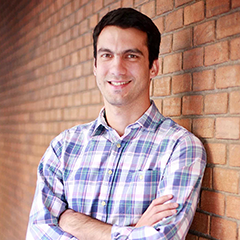Artificial Intelligence-Assisted Technology Saves Eyesight for People with Diabetes in Chile
Diabetes is a chronic disease affecting over 400 million persons worldwide. People with diabetes face complications, one of which is diabetic retinopathy, leading to vision loss and eventually blindness if not detected timely. A young start-up in Chile is using artificial intelligence (AI) to analyze retinal examinations to detect early retinopathy signs.

José Tomás Arenas is the co-founder and CEO of TeleDx, “a start-up which aims to use AI to bring better healthcare solutions.” TeleDx (Dx for diagnosis) was born out of the idea of three inspired people to combine technology and medicine to come up with innovative solutions to address key diseases. In 2011, José Tomás was finishing his degrees in electrical engineering and industrial engineering at the Universidad de Chile. He collaborated with two professors, one of them a medical doctor, to automatize fundus (deep retina) screening for diabetic patients. They chose diabetic retinopathy because it was one of the top ophthalmology challenges and the one that was most likely to benefit from automation.
José Tomás decided to dedicate his professional engineering thesis to the project and delivered a prototype that served as a basis for the platform. The three co-founders launched TeleDx in 2013 with the help of government funding and its main product: DART, a disruptive innovation using algorithms with the technical capabilities of a team of ophthalmologists to hunt signs of diabetic retinopathy.
The disease, he said, although completely preventable, is the main cause of vision loss and blindness in the working-age population in Chile and globally, because of the lack of accessibility to a timely diagnosis, and the fact that it progresses unnoticed by the patients until it is at an advanced stage.
Diabetic retinopathy detection using machine learning
DART substitutes the first stage of the screening so that ophthalmologists can concentrate on the patients at risk. Digital pictures of the patient’s retina are uploaded on the system’s platform and analyzed by algorithms trained with hundreds of thousands of exams that have already been read by ophthalmologists.
The system filters and discards exams presenting no risk of diabetic retinopathy. Scans of at-risk patients are checked by an ophthalmologist, and for those confirmed by the specialist, the platform advises the local health teams so that patients get medical attention.
TeleDx now has four full-time employees and collaborates with a network of medical doctors, mostly ophthalmologists, working on the platform and providing insights on how to improve the product.
DART – the First Approved AI solution in Healthcare in Chile
In 2018, DART became a standard of care for the Ministry of Health and is used by the entire healthcare network, in some 130 points of care, reaching over 200,000 people per year. “We are the only case where a country adopted an AI solution as a standard in health care, and we are very proud of that.”
TeleDx is also looking at selling its service internationally. The company is aiming first at Latin America, home to some 40 million diabetic people needing to be screened yearly. “There are a lot of cases in those countries, and the budgets are not that large. We are aiming at people at the base of the pyramid with affordable solutions even though they are cutting-edge in terms of technology.”
Processing personal data from patients ethically with AI
Artificial Intelligence systems need a constant flow of data to improve their performance. TeleDx has different agreements with hospitals and clinics so it can use their data, explained José Tomás. “Everything is anonymized and we have gone through the ethics committee.” “We have always fairly used algorithms, we use AI so that people are healthier and do things that would not be possible without AI,” he added.
Health Technology Consulting and diagnosis of pulmonary diseases
DART was TeleDx’s only product for a few years but the company later took advantage of the DART experience to innovate further. TeleDx Lab serves as a consulting service for other companies, using TeleDx Lab methodology and algorithms to apply them to other sectors; it could be an incubator for different products. TeleDx Chest is similar to DART and will be used to prevent progress in respiratory diseases by processing digital chest x-rays, looking for tuberculosis, and pneumonia, and was used to look for Covid-19 pneumonia. TeleDx Chest is still in the prototype stage.
TeleDx mainly protects its products with trade secrets and has one registered trademark. They are now considering a mixed model of patents and trade secrets. The latter will be kept as a means of protection “because of the market we are in, the way we launch our products, and the way they are used,” he said.
In the future, “we want to become the AI reference in Latin America in healthcare, be the main player in three or four countries, and build an initial presence in other regions by using AI to improve the quality of life and healthcare of millions of people worldwide, affordably.”
Source: WIPO

 Client Focus
Client Focus